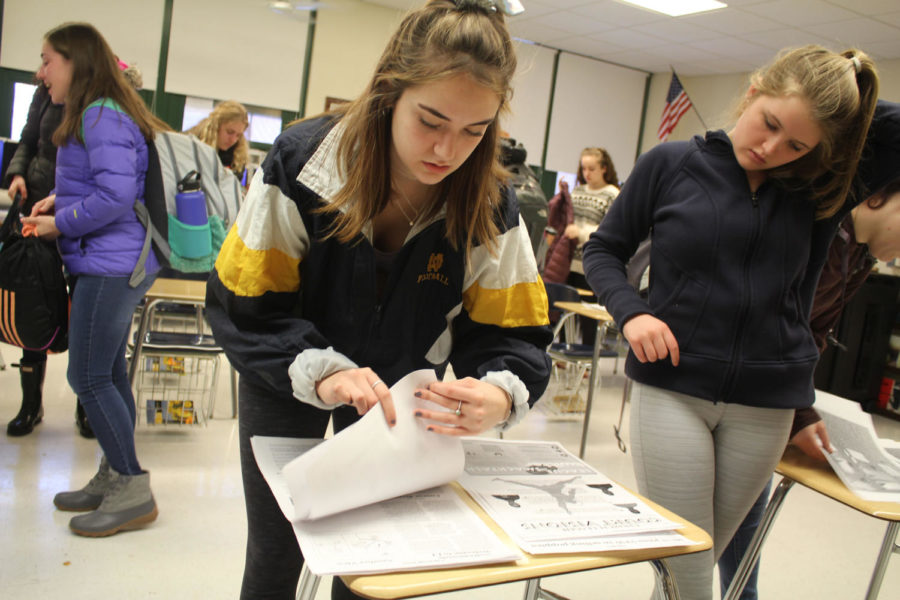Robust student press freedoms used to be the norm. Now, they’re the exception.
Tinker v. Des Moines asserted in 1969 that the right to freedom of speech was just as important for students as it is adults. It’s only gone down from there.
LION Staffer Pilar Valdes looks at the upcoming newspaper issue. This kind of work can only happen with rights for student journalists. (Lonnroth/LION)
February 23, 2019
The LION’s blog Media Mayhem evaluates the implications and the legacy of the Tinker v. Des Moines Supreme Court Ruling to mark the end of Scholastic Journalism Week 2019.
On this day 50 years ago—Feb. 23, 1969—the Supreme Court of the United States handed down a landmark decision: in the case Tinker v. Des Moines, the Supreme Court asserted that the right for students to exercise their freedom of speech is not left at the door when students enter a high school campus.
The Tinker children, Mary, Paul, Hope and John, planned on wearing black armbands to school in protest of the Vietnam War. Before that could happen, however, administrators at the Des Moines Independent Community School District heard about the plan and instituted a policy threatening to suspend students who refused to take off their armbands.
Nevertheless, the Tinkers wore their armbands in violation of the policy and Chris and John Tinker were suspended. Needless to say, they sued the school and the U.S. Supreme Court struck down the school’s policy—and then extended the rights for students to exercise the First Amendment.
The decision provided protections for students to express their opinions on the politics of the day and also enabled student journalists to report on school policies and hold their school administrators accountable for their actions without fear of reprisal.
The suit did not guarantee universal freedom of speech on school campuses, but it did institute the Tinker standard, where in order for speech to be censored by an administration the speech must actually “materially and substantially interfere with” school operation.
In the decision, the court opined that censorship can not be motivated by “a mere desire to avoid the discomfort and unpleasantness that always accompany an unpopular viewpoint” and provided critical protections for student journalists that—at the end of the day—enables quality enterprise reporting on what is happening in America’s high schools.
Unfortunately, in the past 50 years, the court has diluted large portions of the Tinker decision. Some decisions are somewhat reasonable—such as that of the 1986 Bethel v. Fraser case which asserted that vulgarities are not protected under the Tinker decision—but others are not so justifiable. They may also do critical damage to the First Amendment.
Ever since Hazelwood v. Kuhlmeier in 1988, many of the key student press freedoms provided by the Tinker decision were discarded by the Supreme Court and thrown into the judicial garbage can in one fatal throw.
In essence, the Supreme Court asserted that the interests of school administrations—the interest of those too afraid to see their students have the ability to express dissatisfaction about the way in which their schools are operated—were more important than the right for student journalists to report on the issues that truly impact their schools.
In essence, the Supreme Court made student publications more susceptible to becoming puppets of school administrations, and made it more difficult and precarious for student publications to provide important and essential coverage of our school communities.
In essence, the Supreme court tainted the very notion of a free and vibrant student press.
The court argued that because student publications are created and funded by school administrations—operated by newspaper advisors who are paid by the school—that school newspapers are not public forums.
The newspaper’s computers are owned by the school, the newspaper advisor is paid by the school and the printing of the newspaper is paid for by the school’s budget. Furthermore, even if the principal isn’t directly involved in making editorial decisions, if it is paid for by the school it tacitly alludes to a level of approval with the content. As a result, the school should have the ability to have sway over what a student publication can publish. Make sense, right?
However, time and time again, we have seen the real implications of the Hazelwood decision: we have seen administrations crack down on student journalism solely because the truth is uncomfortable.
For instance, a school newspaper in Arkansas uncovered in December 2018 that the school’s football team was breaking transfer rules and the administration forced the newspaper to cease publication. Only after intense public scrutiny from media advocates and professional journalist did the school allow the story’s publication.
In 2015, a high school principal pulled a story discussing student drug use from a school newspaper in Virginia, the Washington Post reports. The principal said that the article was “too mature” for high school students—but students are still using drugs, regardless of whether talking about drugs is too mature for high schoolers.
Additionally, a school newspaper in Kansas uncovered in 2017 that a newly hired administrator had lied about her educational credentials, which resulted in the administrator stepping down. Kansas has laws that prevents the censorship of school-sponsored publications.
But if that occurred in a state like Florida, there are no protections for student journalists and the administrator would have the legal ability to walk into the student newspaper’s newsroom and crush that story way before its publication.
These laws protecting student journalism, dubbed “new voices laws” by the Student Press Law Center, are essential to ensure that a vibrant student press can hold truth to power. Still, Arkansas has a new voices law. Illinois has a new voices law—but school administrators are still censoring.
Last year, students at Evanston Township High School were censored for writing a story on student marijuana use and the efforts in Illinois to legalize it. That’s a pressing issue and the administration had no ground to pull the publication off the racks. Yet, they did.
But still, these New Voices Laws make it illegal for schools to censor their student publications and it certainly makes school administrators think-twice before demanding a story be pulled off the racks.
Only 14 states have new voices laws. This means that administrators in 36 states have literally nothing stopping from walking into a student newsroom and telling student journalists—whose job is to tell important stories about their school community—to not cover a certain story because it “would make our school look bad.”
In reality, what those administrators are saying to student journalists across the country is that these students doing their job will make them—the administrators—look bad. Yes, student journalists need to be guided, but guiding is different from dictating what should or should not be covered.
Would we afford our local politicians the ability to stop the New York Times from publishing a critical article about them? No, because our society has been made better because of our nation’s commitment to a free and independent press. With greater student press protections, America’s schools would be better off, too.





















![Movie poster for '[Rec]" (2007).](https://www.lionnewspaper.com/wp-content/uploads/2023/04/rec-640x900.jpg)



